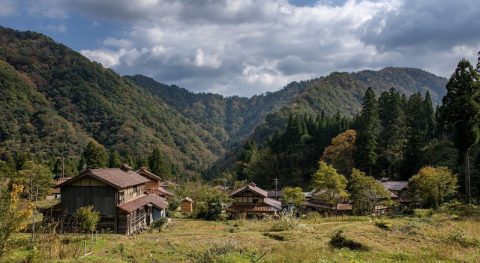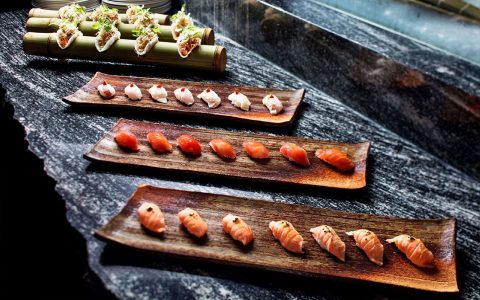In Sake, a Taste for Adventure
Sake rice wine elicits a feeling from the Japanese akin to the enthusiasm Scotch elicits from the Scots and wine elicits from, well, all of us. A drink that inspires endless investigation and discussion, devoted admirers will gladly deconstruct all the aromas and flavours, the subtleties and complexities that distinguish each label from the next. No need to get that in-depth as far as we’re concerned though. Rather, we want to whet your appetite with a brief primer on this traditional Japanese beverage.
Sake: Humble Beginnings
So, to begin, the sake essentials: rice, water and yeast. That’s it. Same as it has always been since someone accidentally (or fortunately) left some wet rice out to ferment in a pot a couple thousand years ago. Refinements over the centuries have obviously taken the craft to the point of high art, depending on how the rice is washed, steamed and polished, which removes the bran from the rice. Some rice is cultivated with mould and then mixed with the yeast, which kick starts the magic of fermentation.
Be sure to always pour for your guests who, in turn, should pour for you.
Entrusted with that magic touch is the brew master, or toji, who guards the secrets and guides the brewing through these stages. Part alchemist, part craftsman, the toji will consistently produce that perfect balance that distinguishes the particular brand, a process that typically takes between 18 to 32 days before it’s pressed, filtered, blended and bottled.
Experience Japan With B&R
Scheduled Group Biking Trip
The wonderful riddle of contemporary Japan is how wholeheartedly it has embraced all things modern—all the while retaining the customs of times past. See history come to life on two wheels on our Japan Biking adventure.
DETAILED ITINERARYScheduled Group Walking Trip
Immerse yourself in Japanese culture, history and nature on our Japan Walking trip, where you’ll stroll through rice fields, ancient bamboo groves, and centuries-old temples as you get a taste of authentic rural Japan.
DETAILED ITINERARYAs Diverse as it is Delicious
 Not unlike its counterpart made from grapes, attempts to categorize sake rice wine have resulted in an endless array of compartmentalized labels and categories, which depend on techniques used in the fermenting process. A more generalized categorization recognizes four main Special Designation sakes depending on the type of rice used and how much alcohol is included. We’ll leave the finer points for the experts, who can explain them to you in much more detail.
Not unlike its counterpart made from grapes, attempts to categorize sake rice wine have resulted in an endless array of compartmentalized labels and categories, which depend on techniques used in the fermenting process. A more generalized categorization recognizes four main Special Designation sakes depending on the type of rice used and how much alcohol is included. We’ll leave the finer points for the experts, who can explain them to you in much more detail.
For now, suffice to say that yes, you can serve it warm, but it’s perfectly acceptable chilled (it’s said warming it tends to mask flavours if the sake isn’t up to snuff). And be sure to always pour for your guests who, in turn, should pour for you.
Leave a Reply
MORE FROM Asia-Pacific + Japan

Biking in Cambodia with B&R Expert Guide Fin
Cambodia
The Slow Fund: Rice Production with Ozuchi Village
Japan
Take a Virtual Ride on the Hai Van Pass in Vietnam
Vietnam
How Three Cambodian Hotels Are Joining Forces to Feed Their Communities
Cambodia
Meet Fin—B&R’s Expert Guide in Cambodia
Cambodia
An Insider’s Eye on Vietnam: What to See and What to Skip, According to our Vietnam Expert
Vietnam
Photo Essay: Exulting in Mongolia’s Eternal Blue Sky
Mongolia
The Best Times of Year to Travel to Asia
Vietnam
Chris Litt: On Mongolia and the Desire to Disconnect
Mongolia
Top 6 Multi-Day Walks in Australia
Australia
The 8 Best Restaurants in Auckland
New Zealand
The 5 Best Restaurants in Wellington
New Zealand
8 Reasons Why You Need to Take an Australian Adventure
Australia
Cultural Quirks About Bhutan That Will Blow Your Mind
Bhutan
5 Things to Know Before You Go to Japan
Japan
8 Favourite Restaurants to Eat in Queenstown
New Zealand
10 Must-Try Australian Wines
Australia
Where to Eat in Hong Kong: 7 Best Restaurants
China
A Kiwi’s Guide to Enjoying New Zealand
New Zealand



This blog was… how do I say it? Relevant!! Finally I have found something which helped me. Appreciate it!